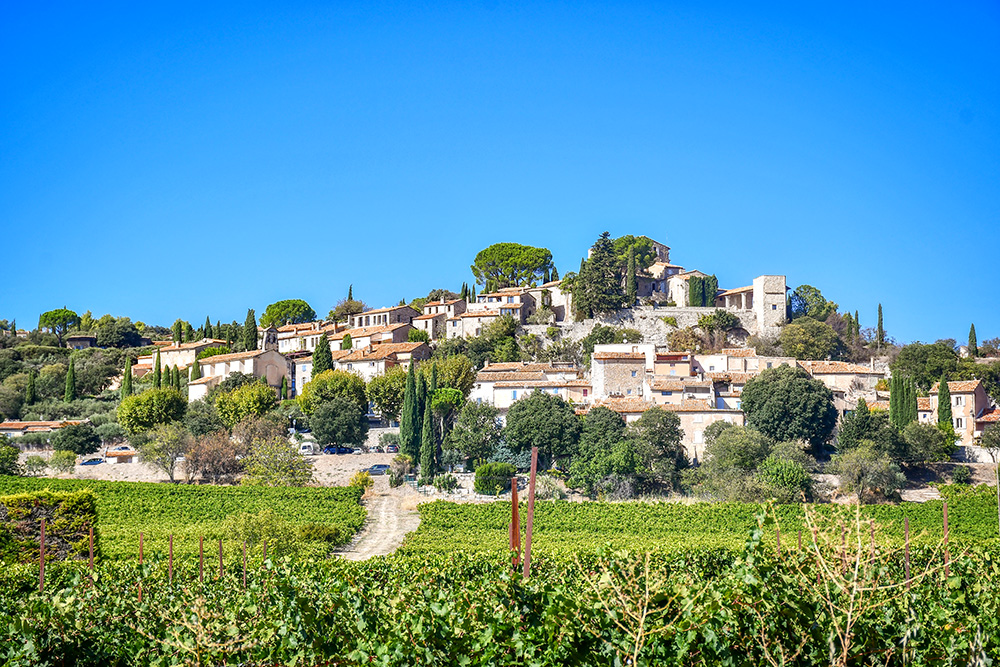Embarking on a journey to discover the hidden treasures of Provence, I found myself wandering into Joucas on a sun-drenched, balmy October day. This visit turned out to be nothing short of a revelation. Nestled in the iconic Luberon and its sprawling vineyards, Joucas presented as a serene escape, a picturesque village that time seemed to have gently passed by.
From the moment I strolled down its Rue Grande (High Street), the warmth of the autumn sun accompanying my every step, I felt a profound sense of peace envelop me. Here was a village that whispered the stories of centuries through its cobblestoned lanes, historic buildings, and the tranquil smiles of its welcoming residents.
As I explored its quaint streets, the majestic countryside views stretching out before me, I knew I had stumbled upon a place where the soul of Provence was vividly alive, inviting me to slow down and savour the moment’s beauty.
This visit to Joucas became more than just a half-day trip; it was a journey into the heart of Provence, uncovering the essence of a region rich in history, culture, and natural beauty. Join me as I share the story of my discovery, a tale of enchantment in a village where every stone, every shadow, and every light tells a story.
Watch this short video on the Luberon!
Why you should visit Joucas
Visiting Joucas is akin to stepping into a living painting, where the vibrant hues of the Provençal countryside blend seamlessly with the historic charm of a serene village.
People should venture to Joucas to experience the tranquillity that eludes more tourist-centric destinations in Luberon.
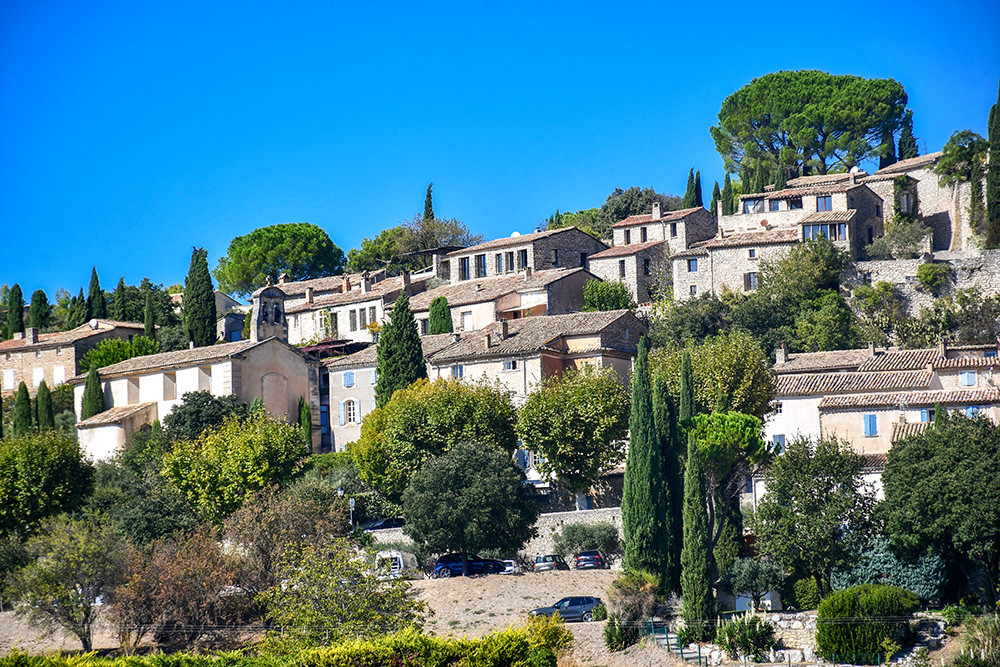
Joucas © French Moments
A Tranquil Provençal Village
Its perched position offers unrivalled panoramic views of the ochre cliffs of Roussillon, providing a backdrop that inspires awe and reflection.
Beyond the visual feast, Joucas invites explorers to delve into a rich historical tapestry, from its meticulously preserved windmill to the enchanting church interior reminiscent of Italian artistry.

Joucas © French Moments
The village's narrow, cobblestone streets and the warmth of its small community embody the essence of rural Provence.
In Joucas, visitors can find a peaceful retreat and a profound connection to the culture, history, and natural beauty that make Provence so uniquely captivating.
Whether seeking inspiration, solitude, or a deep dive into French provincial life, Joucas emerges as a must-visit gem, promising an experience that lingers in the heart long after the journey home.
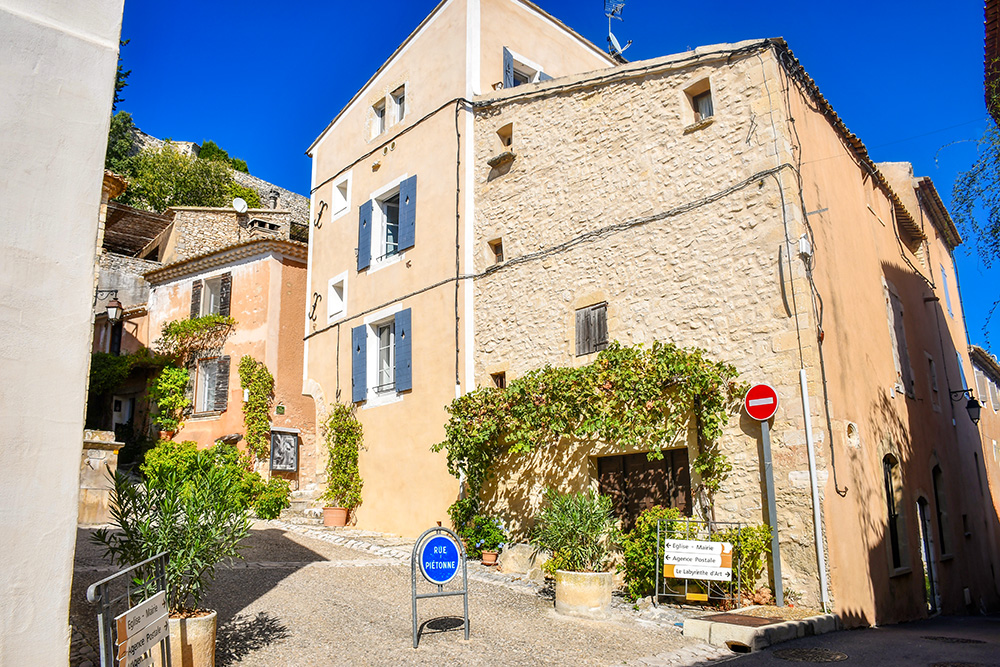
Place de la Fontaine © French Moments
Plan your trip
- 🛏 Find the best accommodations in the Luberon on Booking.com
- 🚙 Rent a car in Avignon or Marseille-Provence Airport
- 🙋♀️ Get the PASS CÔTE D'AZUR and take your pick from more than 100 amazing experiences!
- 🤩 Visit the beautiful Provençal region of the Luberon
- 🚘 Discover Provence in a 2CV. Stroll along exceptional roads and enjoy a piece of Luberon all to yourself!
- 🥗 Experience a black truffle hunting tour in a Luberon plantation
- 📚 Read the DK Eyewitness Provence and the Côte d’Azur Travel Guide
- 🗺 Download the touristic map of Joucas
- 🚻 Public toilets are located at the corner of Rue Grande and Rue du Baumas.
- 🚗 Park at the entrance to the village centre: Route de la Sainte (D102 coming from Roussillon).
Discover Joucas
The best way to start visiting the village is to park in the free car park on Route de la Sainte (D102 coming from Rousillon).
Watch my guided walk of Joucas
A 18-minute video that starts in the lower part of Joucas and climbs to the castle at the top of the village.
The Rue Grande
The Rue Grande is the main thoroughfare through the village, crossing Joucas from east to west.
The street serves the boulodrome, the village's very well-maintained pétanque court.
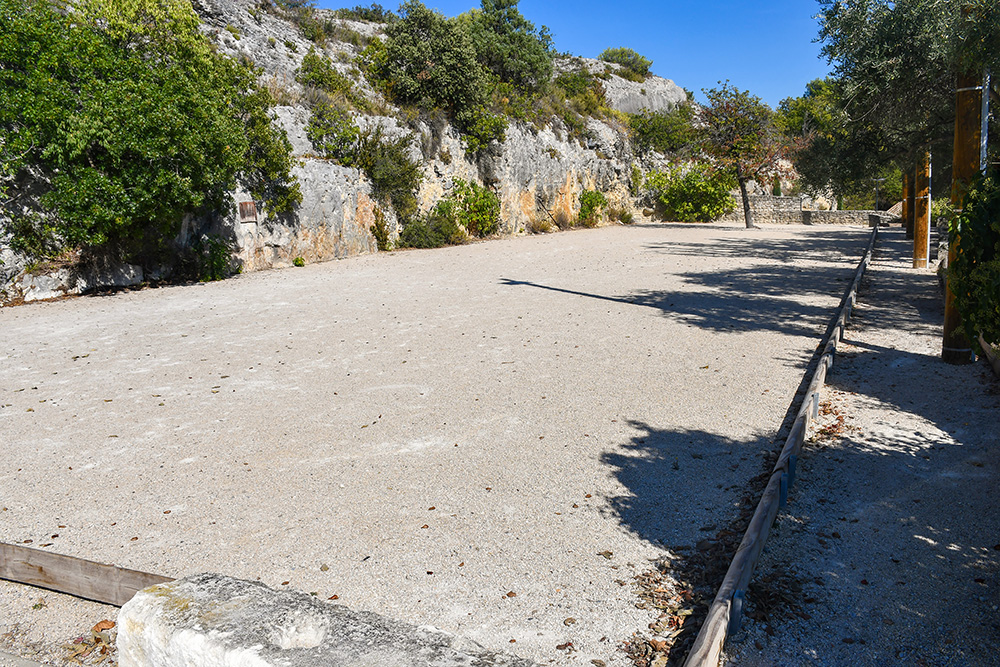
The Boulodrome © French Moments
A word about 'Pétanque'
The first official pétanque competition took place in La Ciotat in 1910.
That's where the game of boules was formalised.
The term “pétanque” comes from the Occitan Provençal words “pè” for “foot” and “tanca” for “stake”, because pétanque is played with the feet firmly on the ground, in contrast to the game of boules where the player can take a run-up.
Further on...
Rue Grande is also where you'll find the village's only food shop (La Joucassienne) and a café.
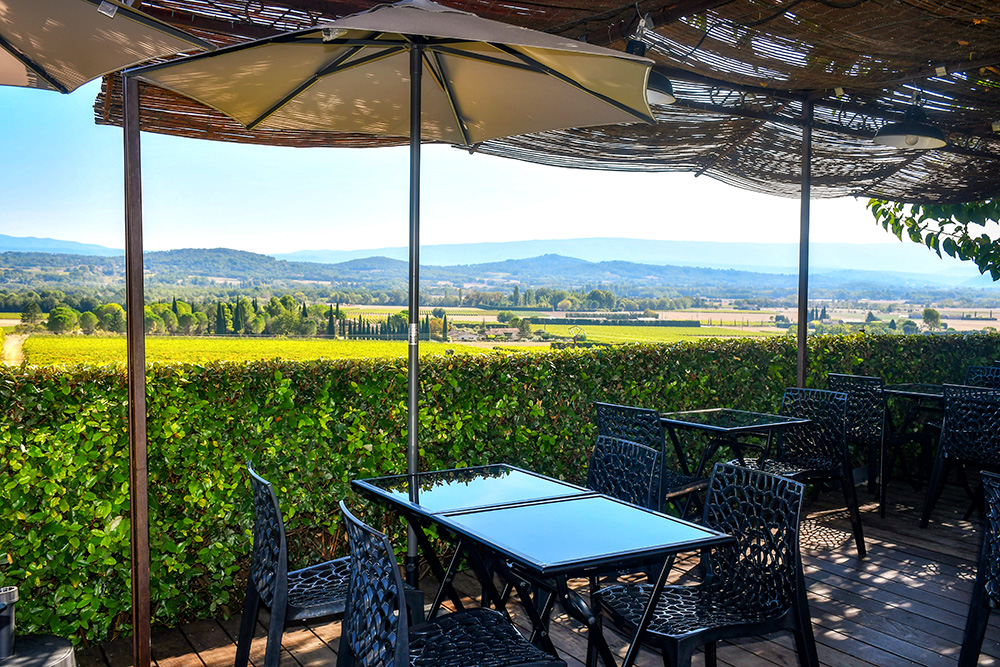
Café terrace in Joucas © French Moments
When the street finally enters the historic part of the village, it becomes narrower, and the houses are tightly packed against one another.

Rue Grande © French Moments
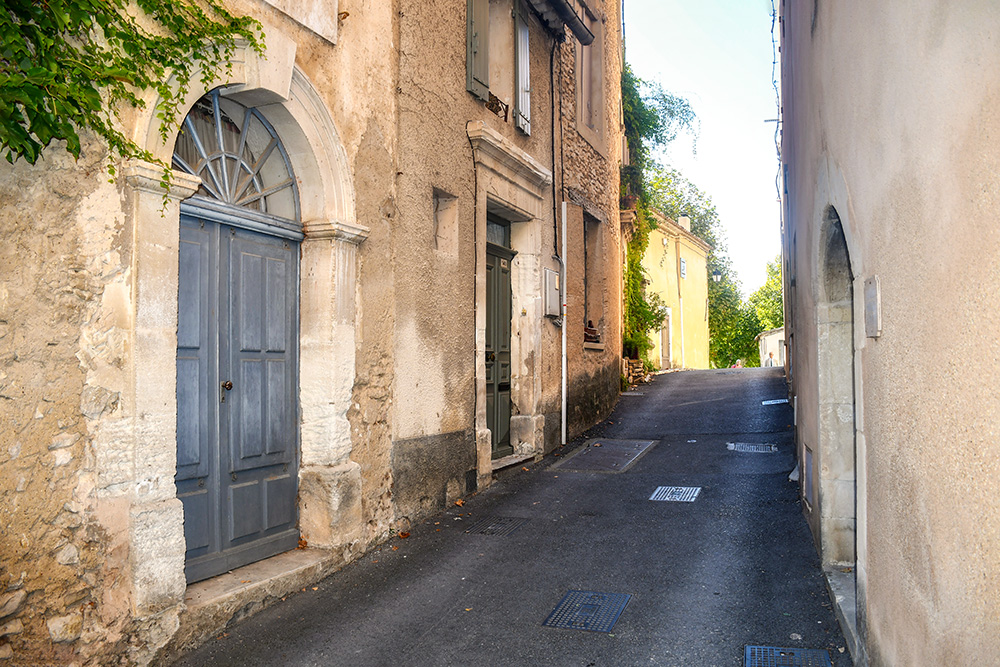
Rue Grande © French Moments
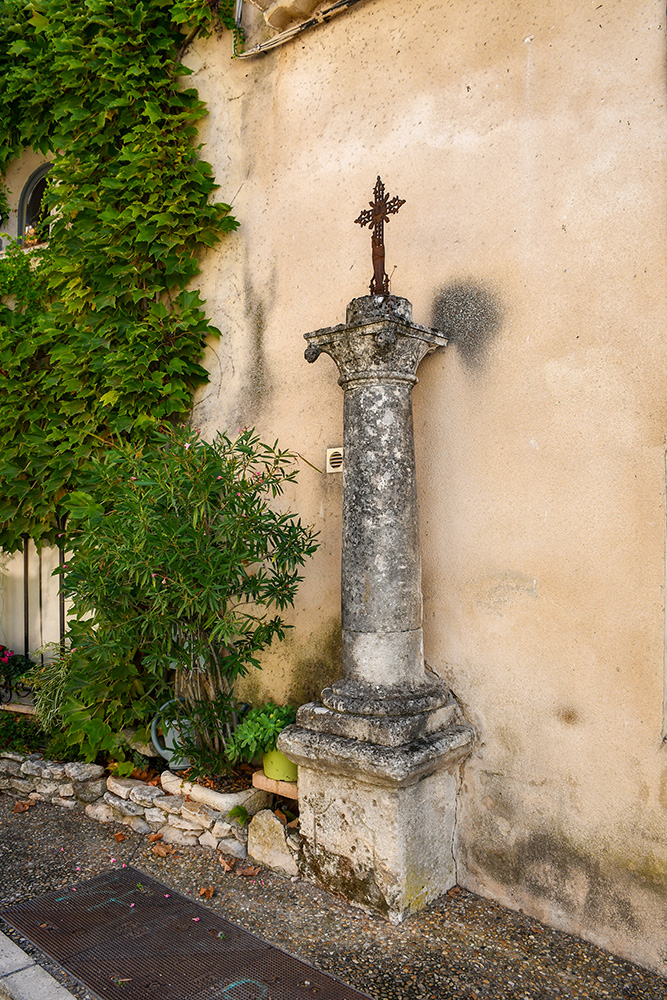
Calvary in Rue Grande © French Moments
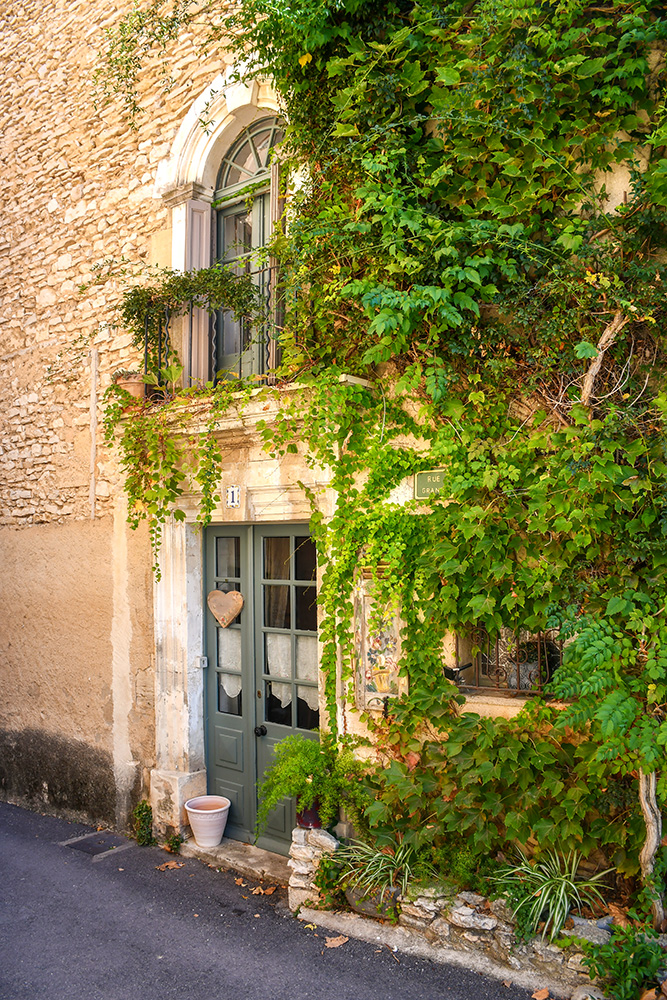
Another view of Rue Grande © French Moments
Just after the intersection with the Place de la Fontaine, have a look at the terrace lined with old plane trees. There is a fine view over the vineyards - a lovely picture of rural Provence!
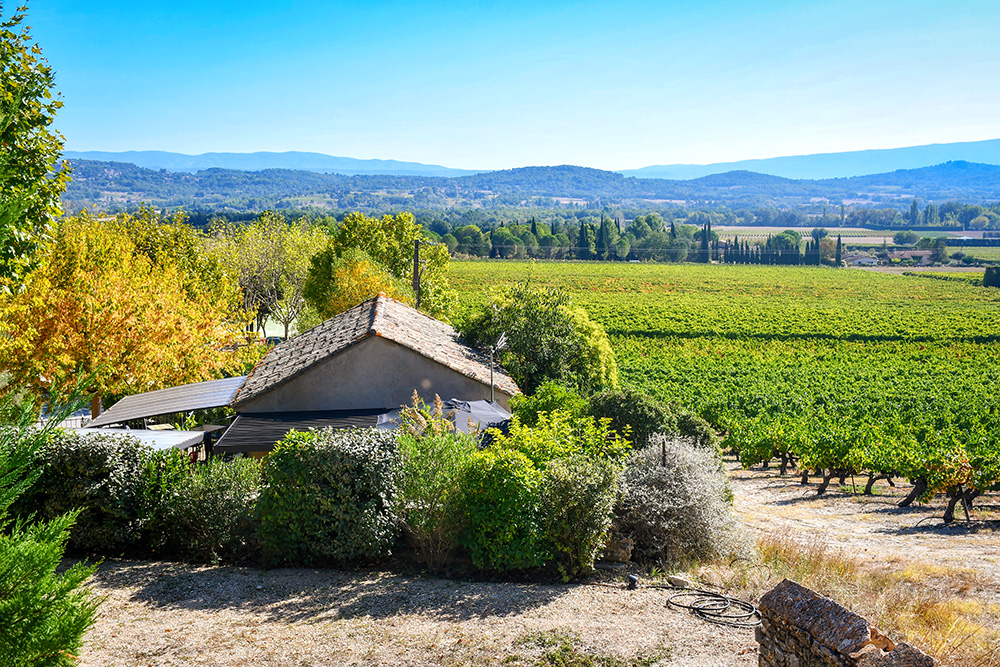
The view from the village © French Moments
Place de la Fontaine
The charming square of Place de la Fontaine has the village's old wash house, which was restored in 1960.

Place de la Fontaine © French Moments
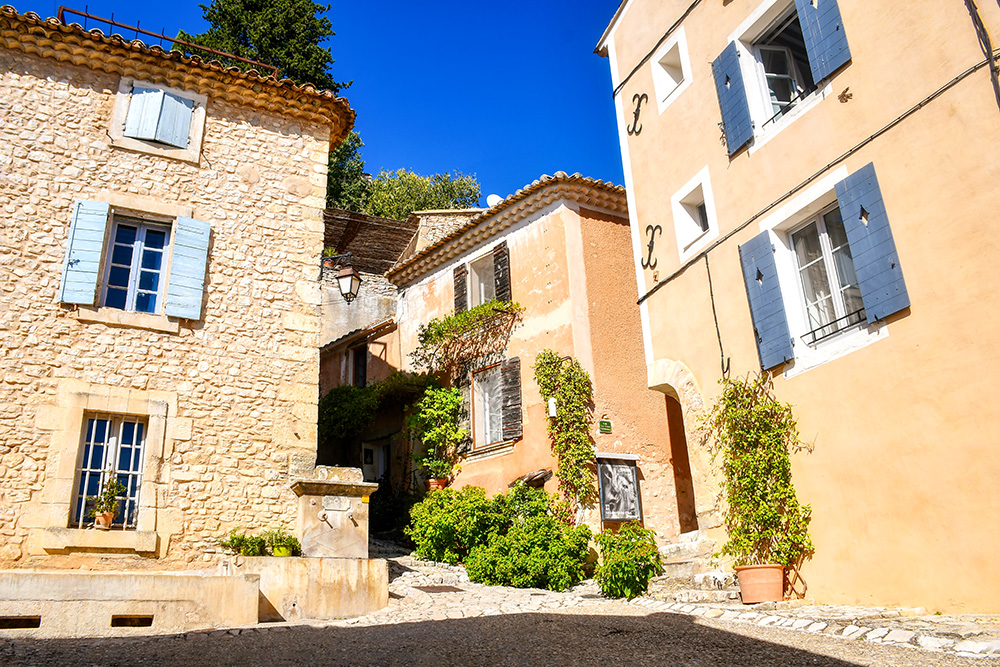
Joucas: Place de la Fontaine © French Moments
The Rue de l'Église leads to the town hall and the church.
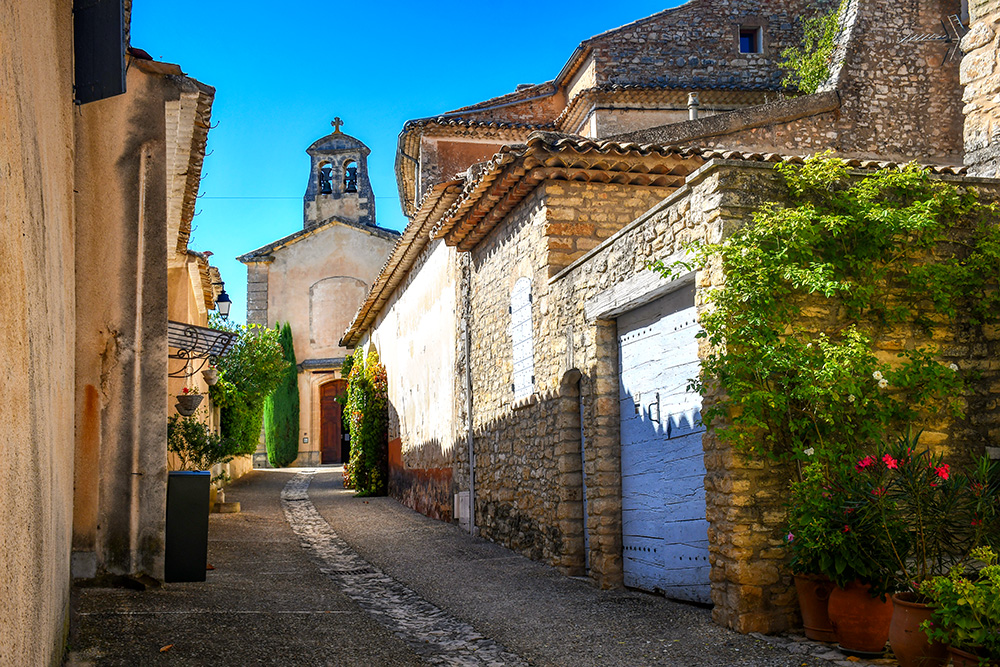
Joucas: Rue de l'église © French Moments
Place de l'Église
The small Place de l'Église is bordered by the town hall and the church. It also commands a fine view over the countryside.
The Town Hall (la Mairie) has occupied the former presbytery since 1920. The village of 350 inhabitants doesn't have a tourist office, but it's good to know that the town hall has tourist brochures of the region. You can go there to get some when the town hall is open.

La Mairie © French Moments
Eglise Saint-Jean-Baptiste
Until the Wars of Religion, religious services seemed to have been held in the Notre Dame chapel in the district of the same name.
Then, the castle chapel, after its reconstruction, served as the parish church until the construction of the current church, on this esplanade to the east of the village, from 1766 to 1770.
Like many Provençal churches, the exterior of Joucas church is very austere.
But once inside, it feels like stepping into a real museum of Italian art with its trompe l'oeil paintings.
The fabulous interior of the church
The interior decor is a veritable museum of trompe-l'œil painting. The pilasters, arcades, and windows surrounding either side of the nave feature excellent faux marble.
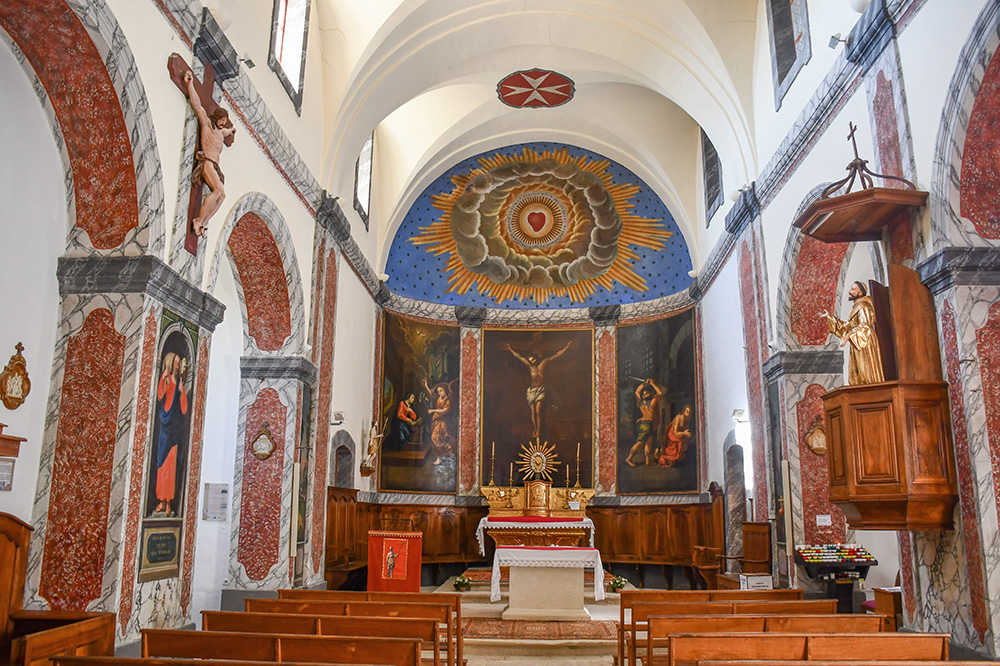
Inside the Church © French Moments
The arcade pillars feature three paintings of saints, depicted as statues (Saint Peter and the Good Shepherd on the left and Saint Paul on the right), all in Provencal style and dating from the 18th century.
A series of four decorative paintings appear on the four corners of the nave: scenes of processions or hermitages representing penitence.

The pulpit © French Moments
The choir vault is painted with a celestial ceiling of clouds, with the Sacred Heart in the background and the Maltese cross in the centre.
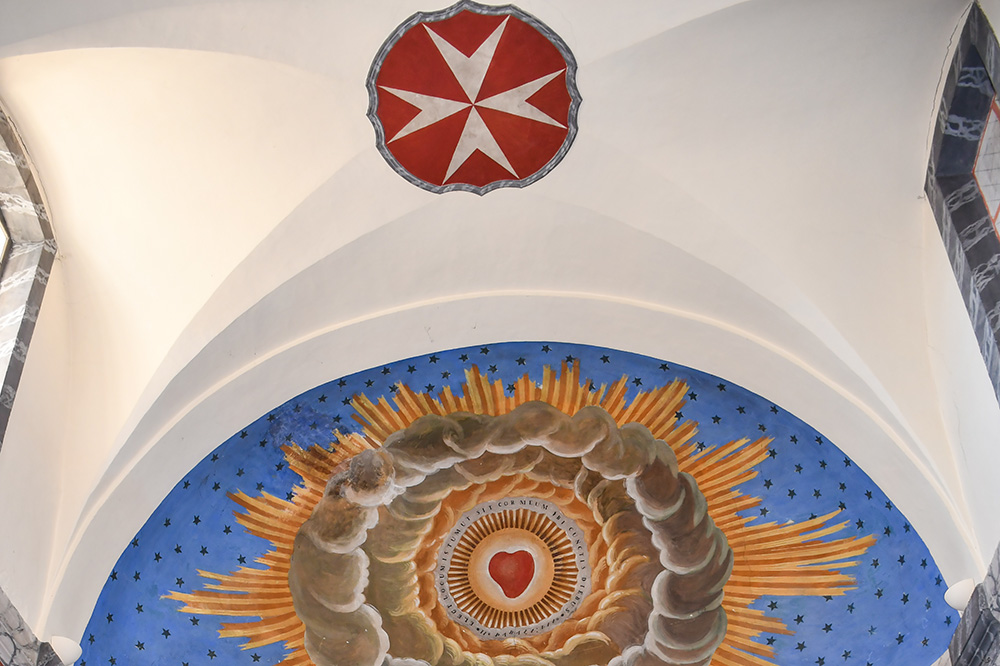
The choir's ceiling © French Moments
The church contains several large paintings, most of which are anonymous.
The ensemble is completed by a beautiful gilded wooden altar, the choir stalls, the confessional, and the walnut door leaves of the entrance.
The Calades of Joucas
Joucas has delightful and picturesque little winding streets, paved in the old stepped manner, which can only be discovered on foot.
In Provence, these streets are called "calades". They are emblematic of the rustic charm and enduring heritage that permeate the provençal villages.
These traditional cobblestone streets, meticulously assembled from local stones, meander through the heart of the historic village, inviting wanderers to step back in time.
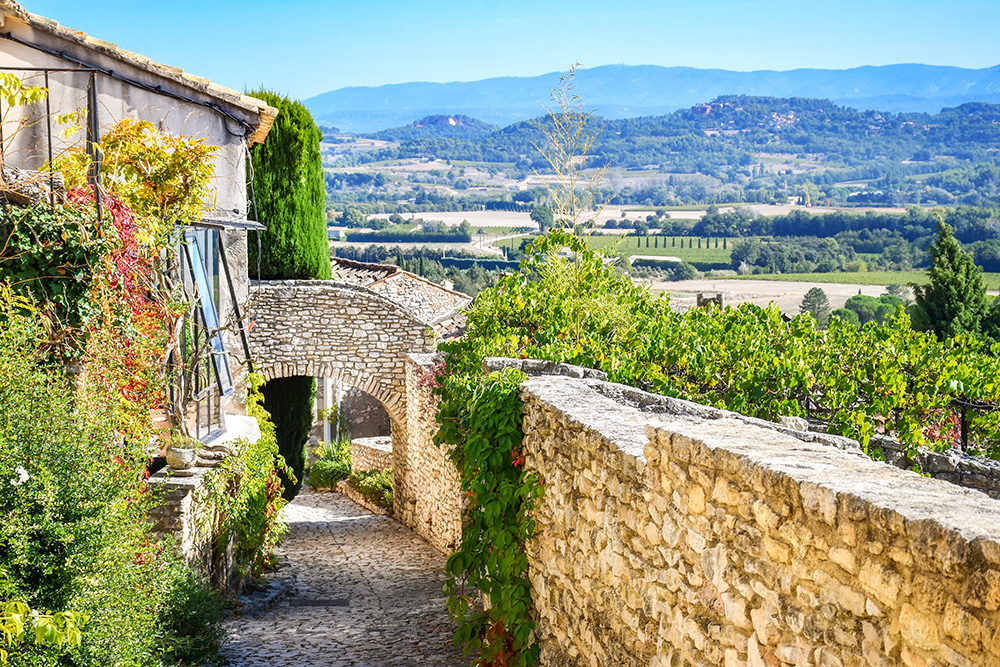
Joucas (Calade du Potier) © French Moments
Calades are not just pathways; they are artful expressions of craftsmanship, where each stone is carefully placed to create not only a durable surface but also a picturesque landscape feature.
Walking on a calade, one feels the tactile connection to centuries past, as these streets have borne witness to the daily lives of generations.
Their uneven, sometimes steep inclines add to the authentic character of Joucas, blending seamlessly with the surrounding natural beauty and architectural splendour.

Calade du Potier © French Moments
Calade du Potier
The Calade du Potier runs from the Place de la Fontaine up to the Place Céleste.
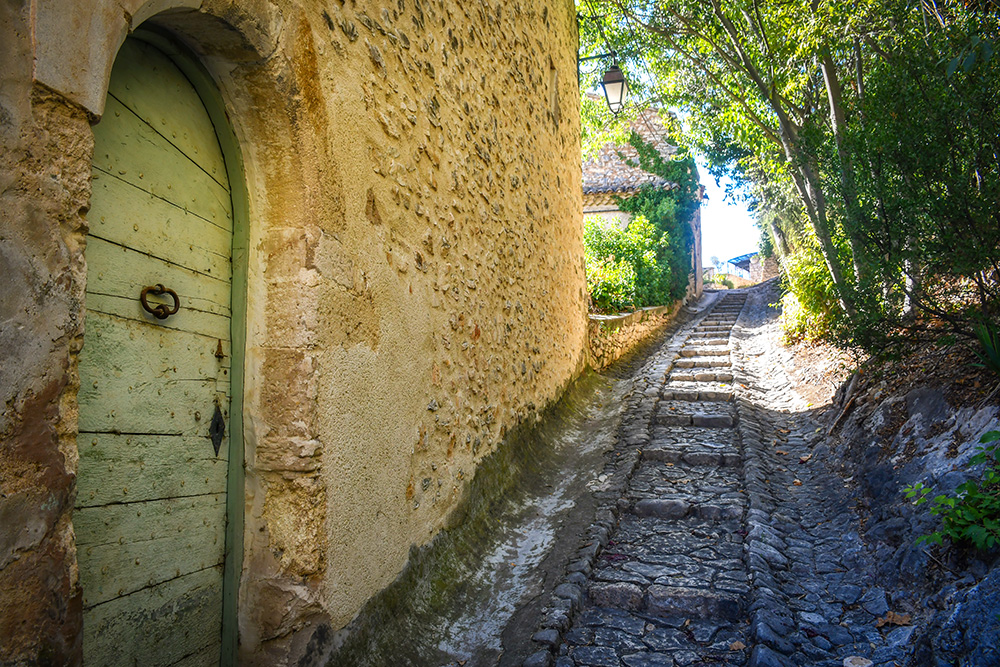
Calade du Potier © French Moments
The first part of the ascent takes place in the shade of the trees, then, from the intersection with the Calade de la Commanderie, takes on a more village-like feel as it is lined with carefully restored rural houses.
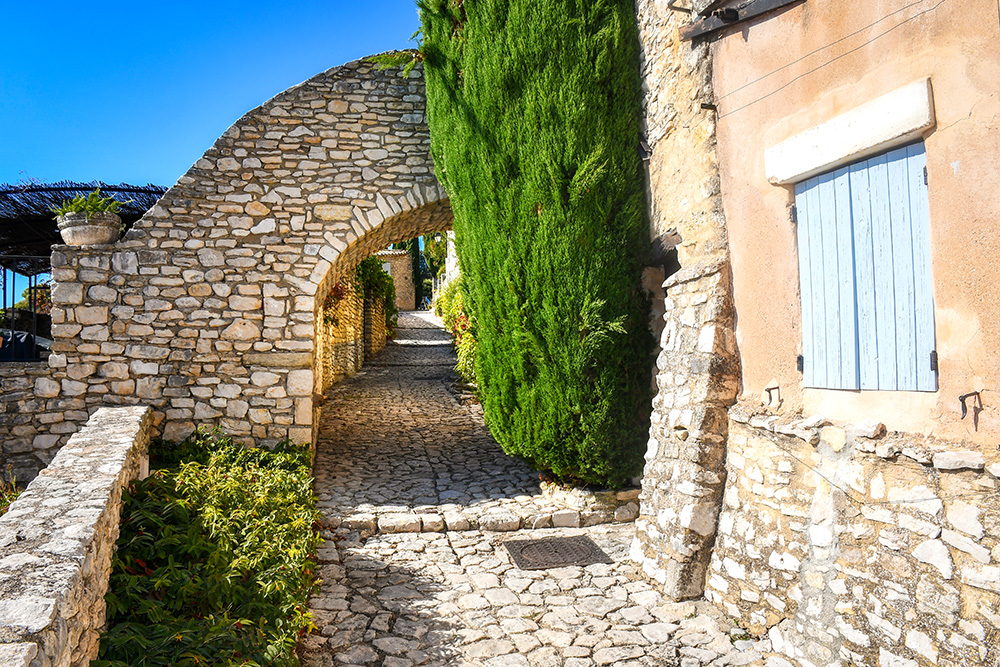
Joucas (Calade du Potier) © French Moments
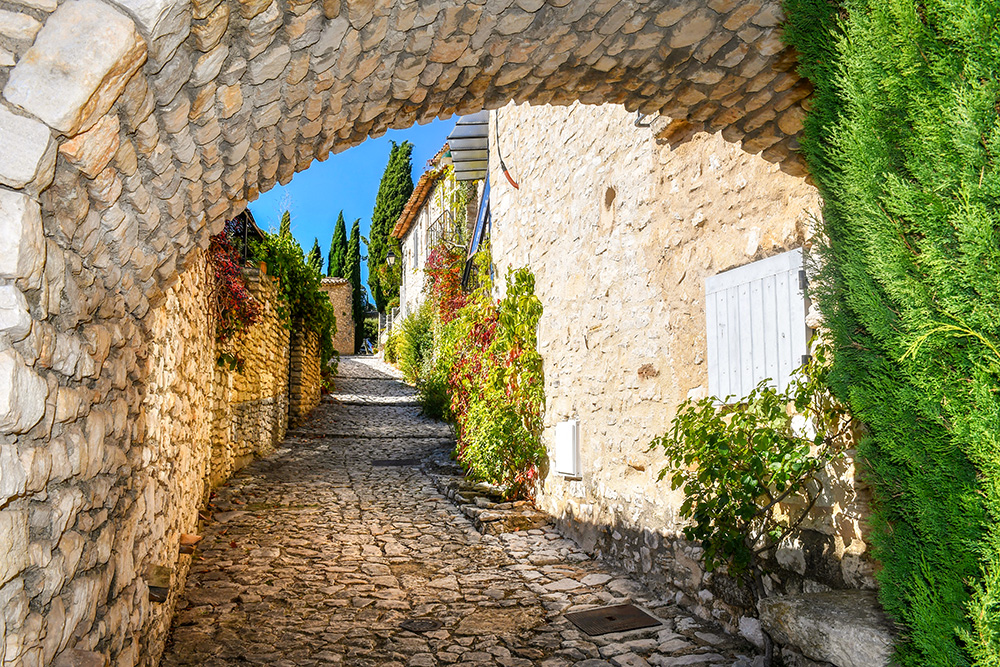
Calade du Potier © French Moments
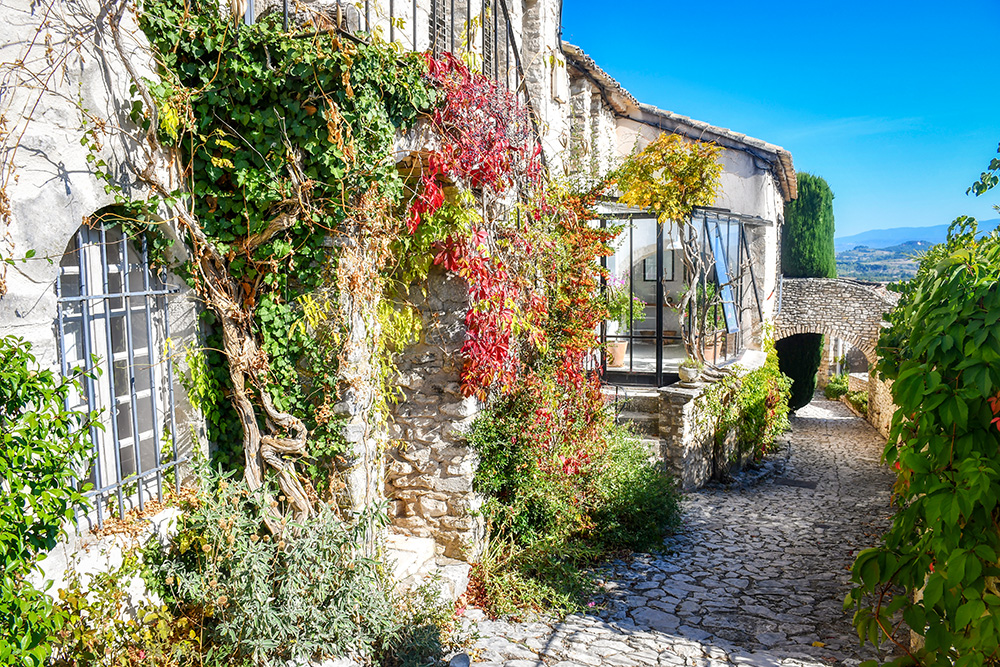
Joucas (Calade du Potier) © French Moments
The Calade du Potier offers some fine views of the village's rooftops and the church.

Joucas Church © French Moments
Calade de la Commanderie
The Calade de la Commanderie leads to the top of the village and up to the entrance to the château (now privately owned).

Calade de la Commanderie © French Moments
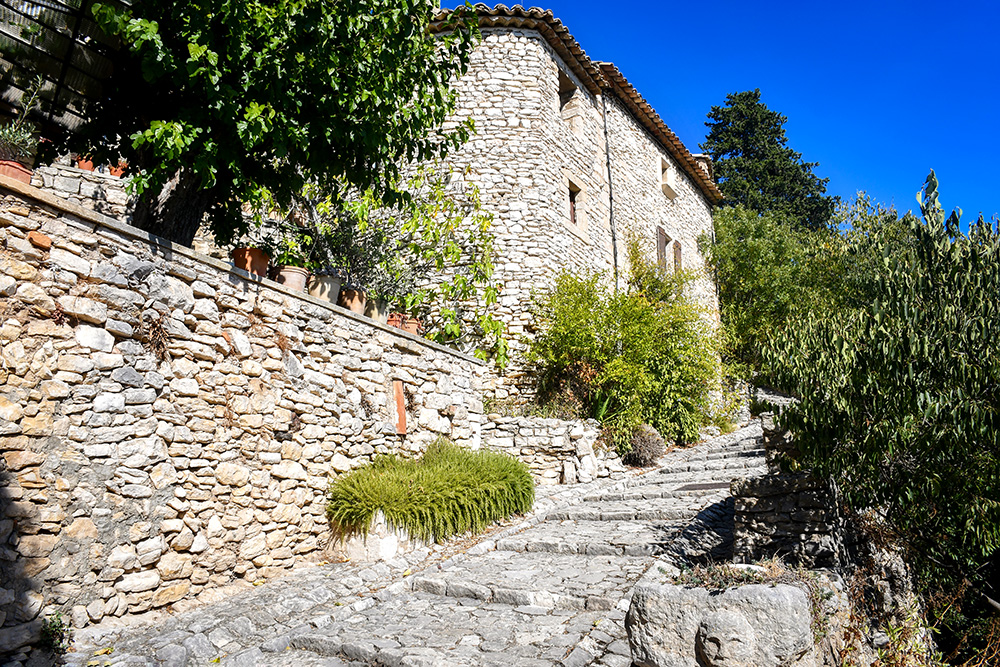
Ascent by the Calade de la Commanderie © French Moments
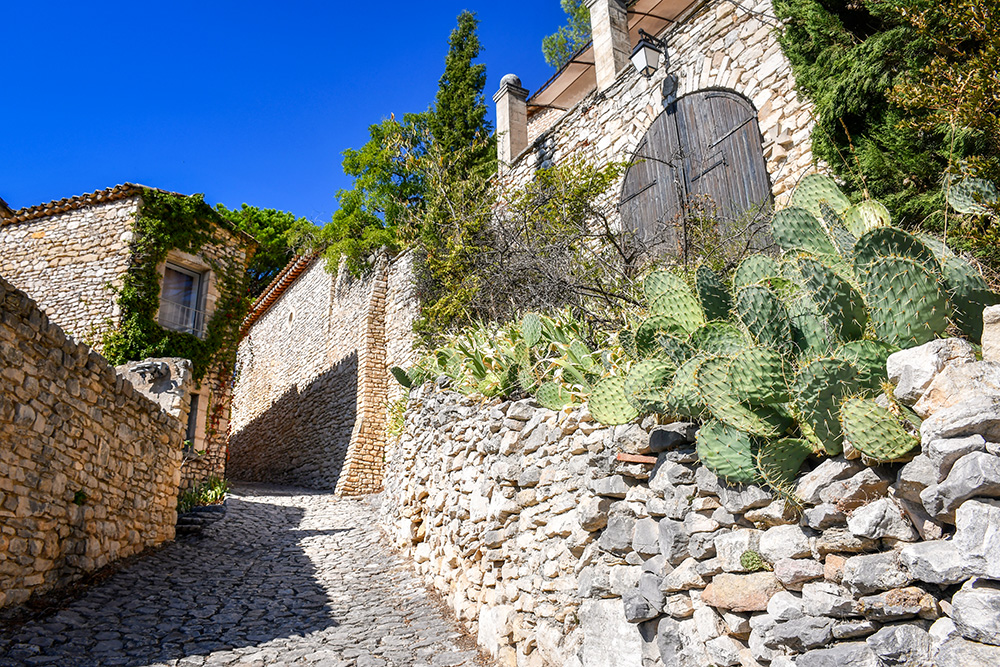
Calade de la Commanderie © French Moments
The lane offers a magnificent panoramic view over the roofs of Joucas, the village of Roussillon and, in the distance, the village of Saignon and the Grand Luberon.

View from Joucas (Calade de la Commanderie) © French Moments
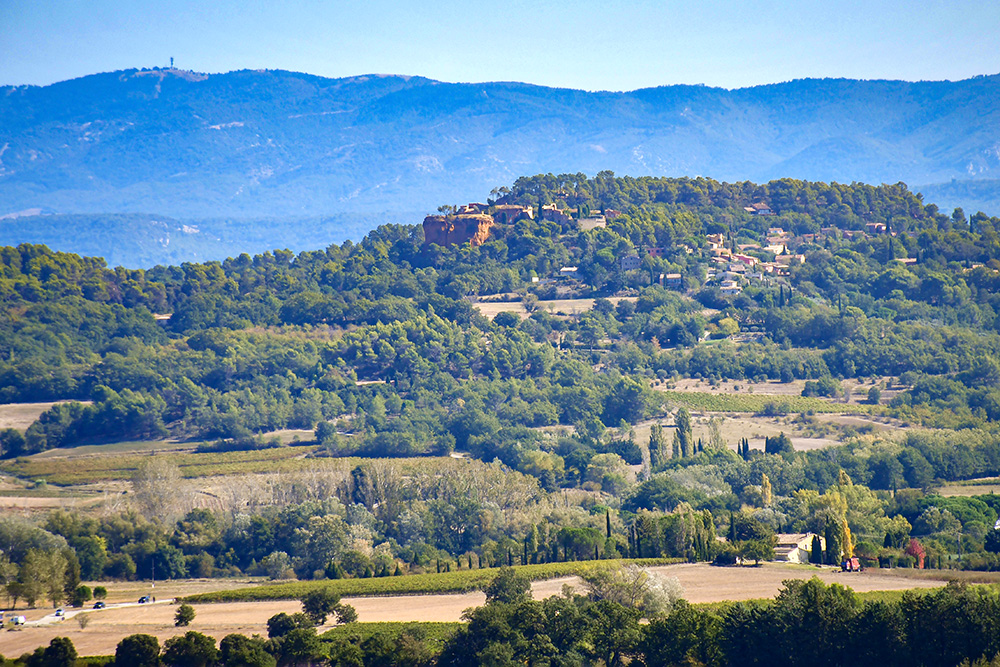
Roussillon and Grand Luberon from Joucas © French Moments

View of Saignon from Joucas © French Moments
Rue du Four Communal
The Rue du Four Communal is a charming corner of Joucas with its beautiful stone houses.
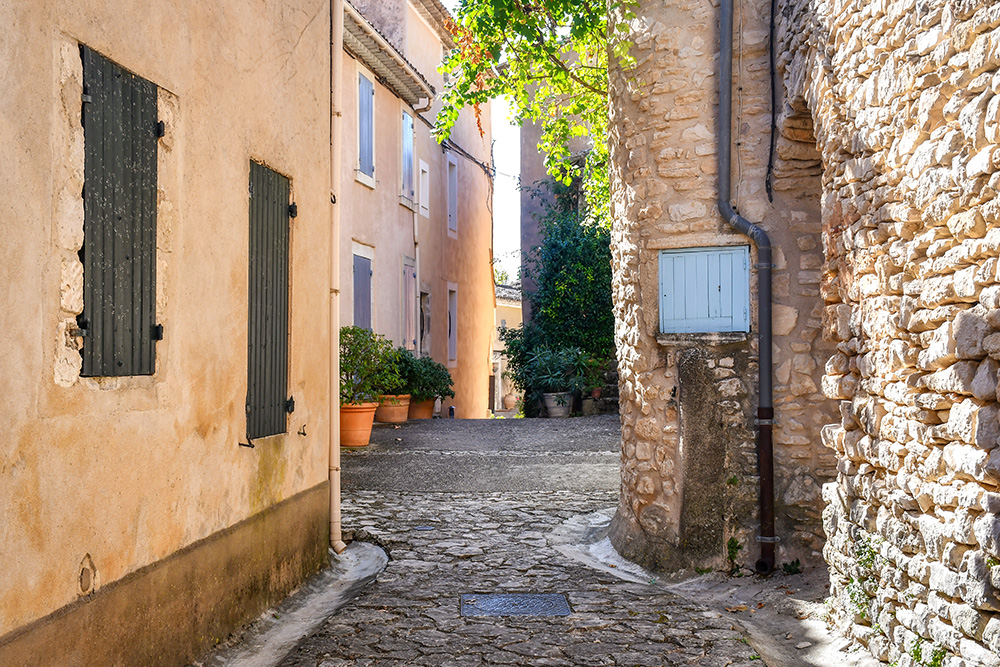
Rue du Four Communal © French Moments
As its name indicates, this is where the public oven was once located.
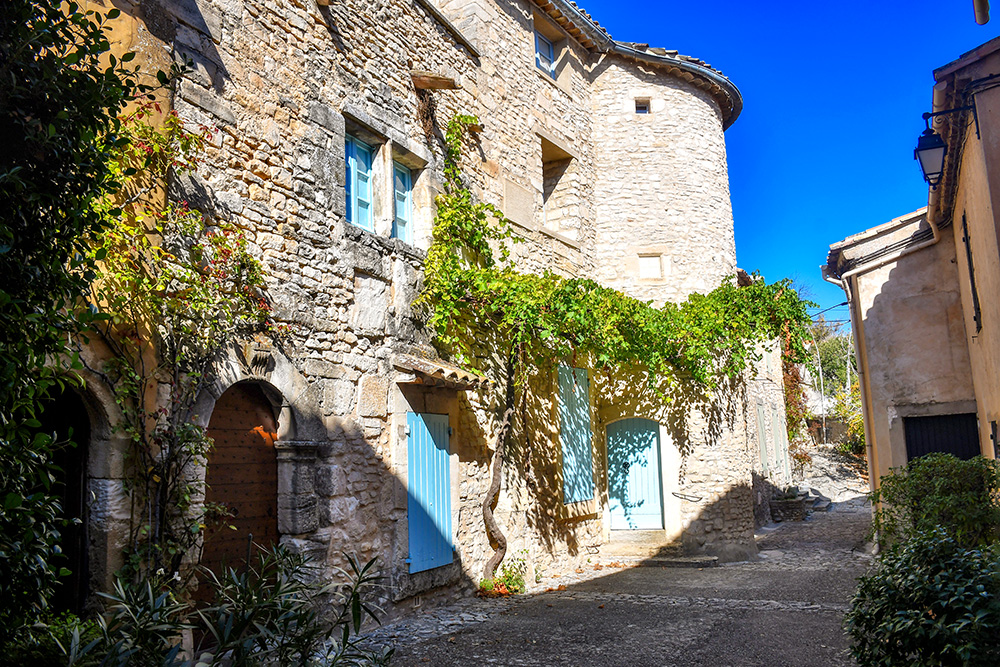
Rue du Four Communal © French Moments
Labyrinthe des Arts
Exploring the village, you'll come across several monumental sculptures of the "Labyrinthe des Arts.”
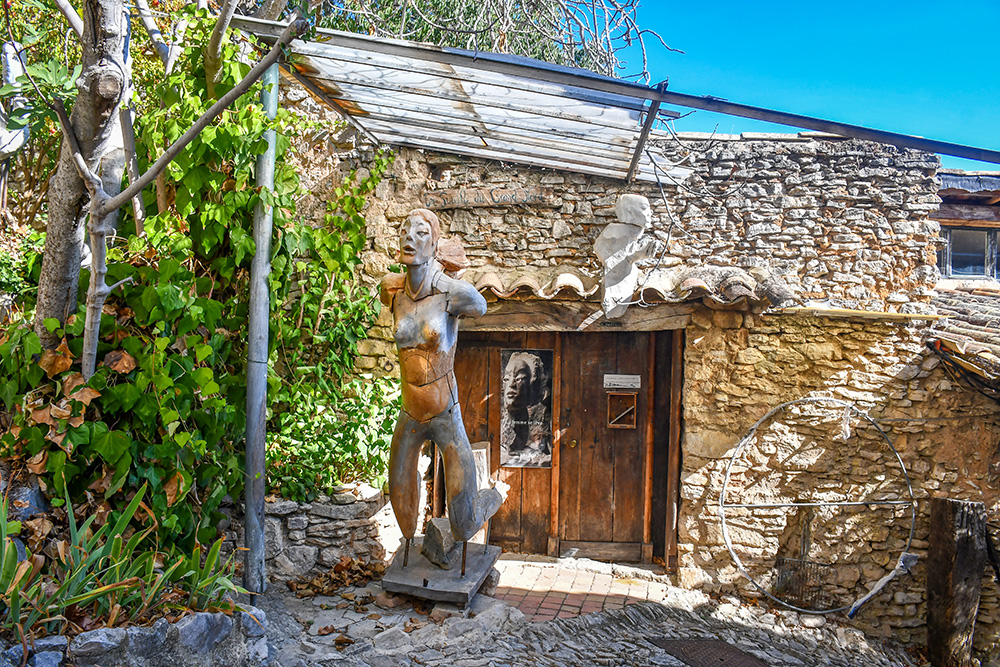
Sculptures in Rue du Four Communal © French Moments
These works by Marion Heybroek and Ulysse Plaud, two nomadic artists who chose Joucas as their last residence, are meant to provoke thought on humanity.
The former Commandery (Castle)
The castle at the top of the village is actually a former Templar Commandery. The estate is now a private property.
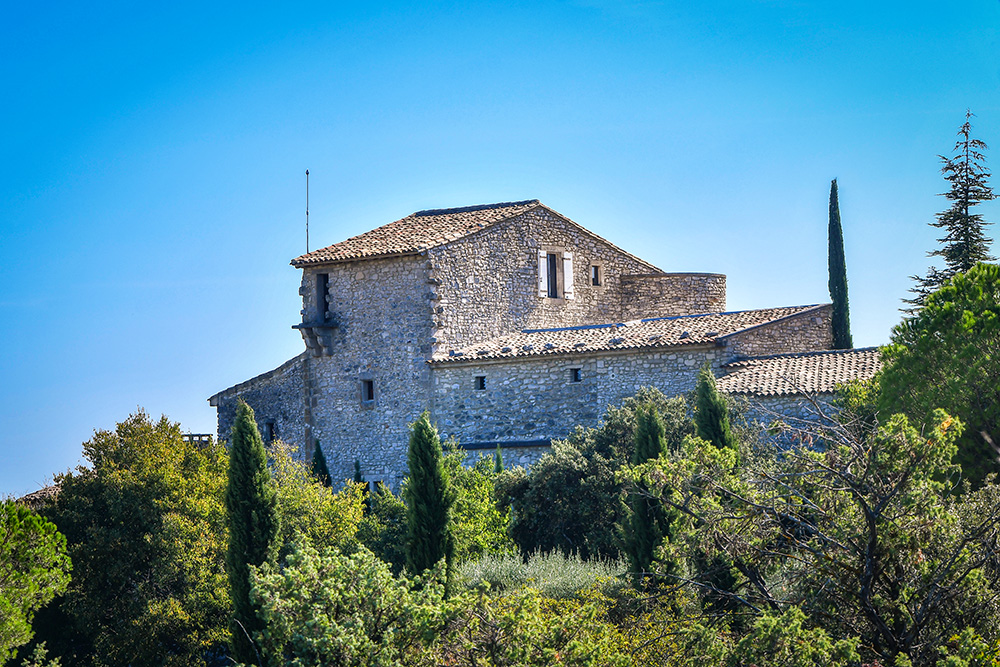
The Commanderie (castle of Joucas) © French Moments
The origins of the Commandery
Located in the foothills of the Monts du Vaucluse, Joucas is one of France's most beautiful and charming villages and is characterised by a certain discretion due in part to its geographical location and history.
The village was founded in 960, and traces of Joucas (castrum de Jocas) can be found in a charter from the Abbey of Saint-Victor de Marseille dated 1055.
The place was first the possession of the Bishop of Apt. From the end of the 11th century until the 17th century, it was owned by the D'Agoult-Simiane family.
The Knights Hospitaller of Saint John of Jerusalem
In the 13th century, Joucas was handed over to the "Knights Hospitaller of Saint John of Jerusalem," which would become "the Order of Malta."
The Templar Commandery is a place rich in history that served as a refuge and a caring place for travellers and pilgrims.
It was once the centre of significant Templar activity, managing several farms in the Luberon Valley.
In the 12th century, the Hospitallers of Saint John of Jerusalem built a fort at the top of the village, around which several peasant families came to settle.
But the village was deserted in the 14th and 15th centuries.
To repopulate it, the Waldensians were called upon.
The Waldensians in Joucas
Thus, Joucas became part of the forty or so localities in the Luberon where at least 1,400 families of Waldensians from the Alps, or about 6,000 people, came from the Alpine dioceses of Turin and Embrun between 1460 and 1560.
However, the majority of the population with Waldensian tendencies joined the Reformation and then converted to Protestantism.
As a result, the general persecution of the Waldensians in Provence affected the village in the 16th century.
Crimes were committed on both sides. For instance, the Lord Commander was murdered, and his body was thrown into a well.
In 1663, the castle of the Commandery was demolished by Catholics before being rebuilt.
From the 18th century
During the French Revolution, the fortress was again besieged and partially destroyed.
The property was sold in 2006 to an English businessman.
The Joucas Windmill
The Moulin à Vent de Joucas (Joucas Windmill) is situated on the Route de Murs, at the east exit of the village.
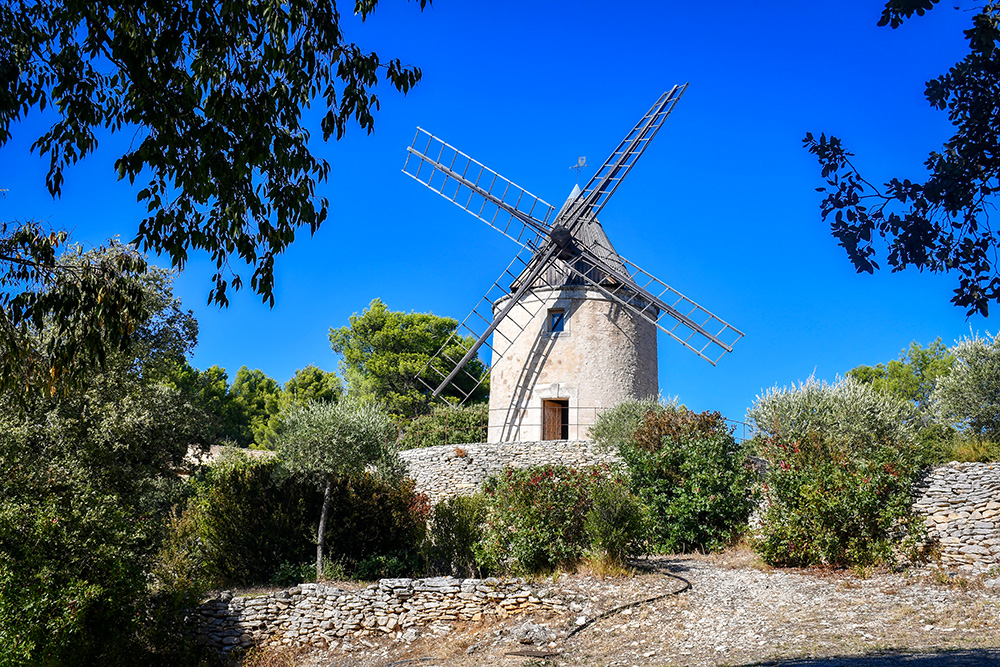
Joucas Windmill © French Moments
Built around 1850 to grind grain, it stands proudly with its wings and conical roof.
A puzzling windmill
However, this mill is a puzzle in itself.
At the time of its construction, windmills were no longer in vogue.
One wonders why its owner, Jean Cortasse, was so keen on building it at a time when the industrialisation of grain milling was taking place thanks to steam power.
Indeed, water mills continued to operate for a long time.
However, for windmills, which are fragile and complicated to monitor, it was instead the era of their disfavour.
Moreover, this mill must not have functioned for very long, about 25 years.
Thus, by 1901, it was already classified as a ruin.
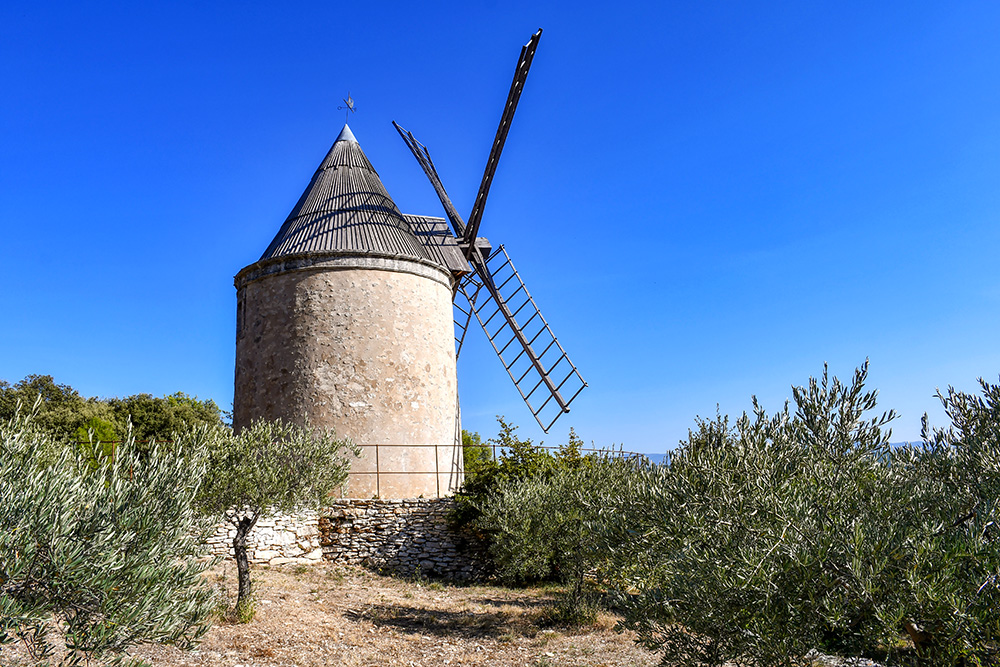
The Joucas Windmill © French Moments
So, why did Jean Cortasse wish to build a mill?
Was it to take advantage of the gradual shutdown of the water mills of the Véroncle, seeing it as an opportunity?
Did he have a passion for windmills?
Perhaps, it was a mark of prestige?
We will never know!
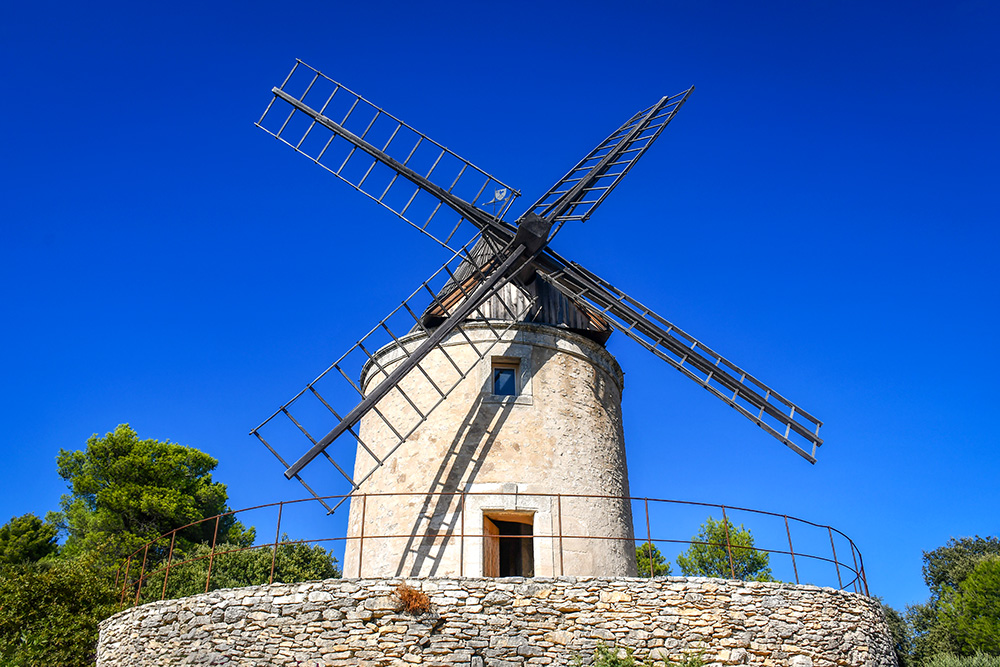
The windmill © French Moments
Inside the windmill
Good news! You can enter the mill to visit the interior, and reach the first floor by a spiral staircase.
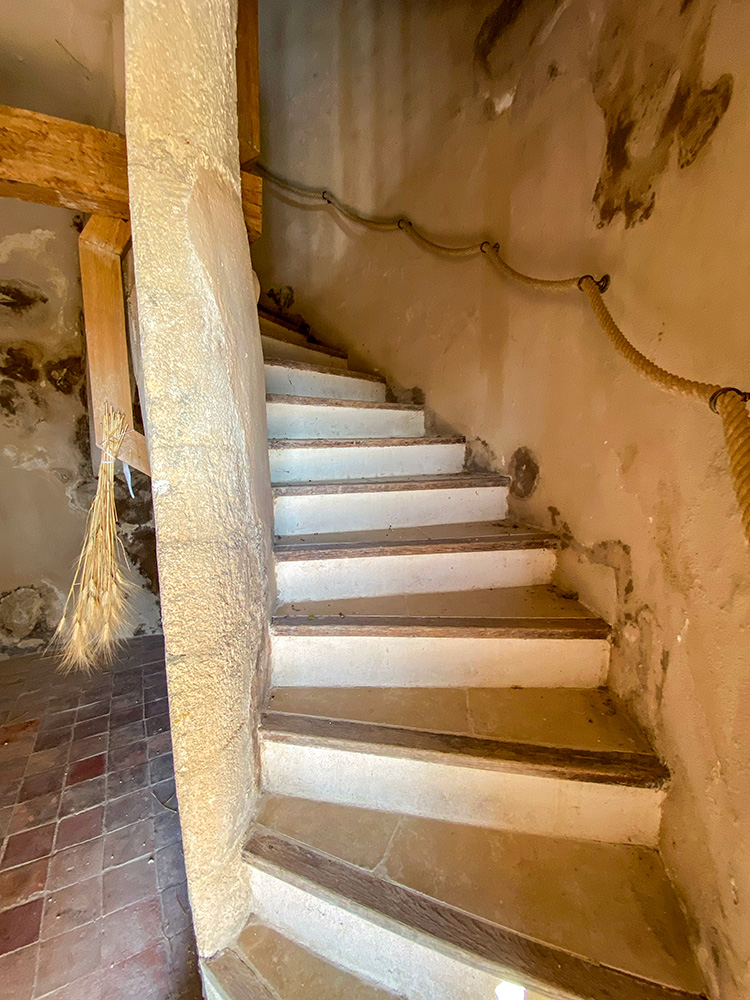
The spiral staircase inside the Joucas Windmill © French Moments

The windmill mechanism © French Moments
There, you can see the flour production mechanism that has recently been restored.
If the topic of windmills interests you, written information in French is displayed on the wall.

The weather wane © French Moments
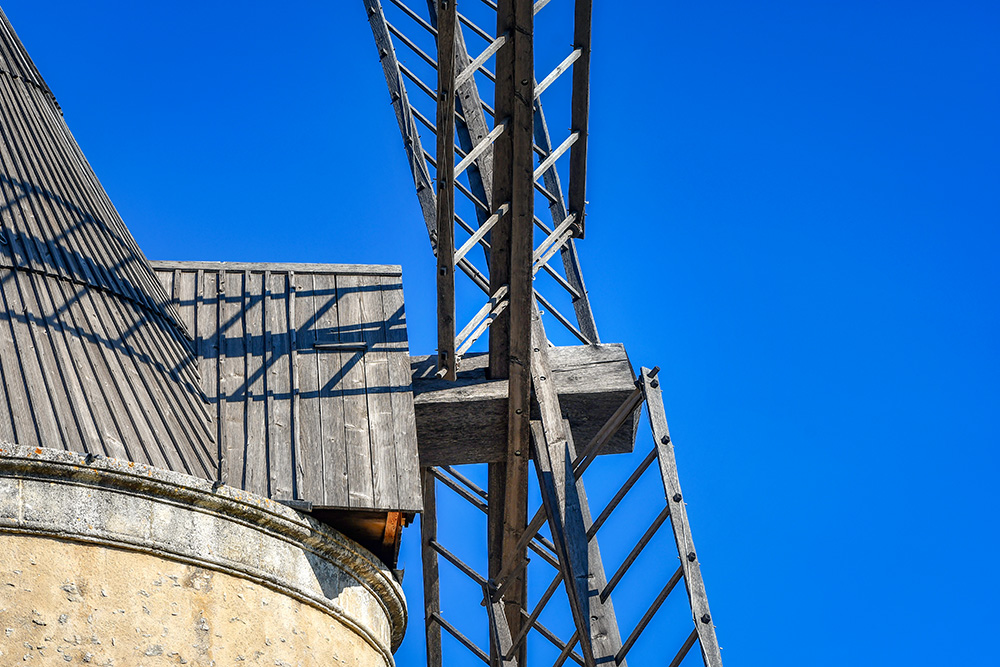
Detail of the sails © French Moments
Find out more
Here are some pages from our blog and other websites to find out more about this Provencal destination.
- Discover the rural region of the Luberon in Provence
- Find out more about Provence-Alpes-Côte d'Azur
- The official tourist office of the area

Directions from Joucas © French Moments
Where to stay in Joucas
Joucas and surroundings have a high capacity for holiday accommodation. The commune has hotels, bed and breakfasts (covering all price ranges), estate agencies offering seasonal rentals and gîtes.
Click here to book your accommodation in the Luberon or browse the map below:
Shops and restaurants in Joucas
So, by now you'll have gathered that Joucas is a tiny village that one can quickly tour around. But it's a little gem of the Luberon, set apart from the major tourist destinations like the neighbouring villages of Gordes and Roussillon.
True, the village suffers from a lack of real commerce. There's only a café, a restaurant, and a small food store. But maybe that's what makes it very pleasant and peaceful!

La Joucassienne © French Moments
Here is a small list of shops and restaurants in Joucas. Please note that this list is indicative and may change over time.
Shops and amenities in Joucas:
Ma Petite Epicerie La Joucassienne (grocery store)
Rue Grande - Open every day 7.30am-1pm (Closed on Wednesday) - website
Agence postale (post office)
Place de l'église (Mairie) - Open every day in the morning (Closed on Sunday) - website
Médiathèque (library and media centre)
120 Rue de la République - open every Tuesday and Thursday from 3pm to 6pm, except in July (5pm to 7pm) - Access to the media library and consultation of documents on site are free. However, to borrow documents from home, you need a subscription. website
Cafés and restaurants in Joucas:
Bistrot La Terrasse (café)
Grande Rue
Restaurant Agachoun (Le Joucas) (restaurant)
288 Rue Grande - website
The nearest supermarkets to Joucas:
Super U in Coustellet (13 km / 8 mi) - website
Lidl in Apt (14 km / 8.5 mi) - website
E.Leclerc in Apt (15 km / 9 mi) - website
What to do in the Luberon
Be inspired by a list of things to do in the Alpilles and surroundings:
Pin Joucas on Pinterest


